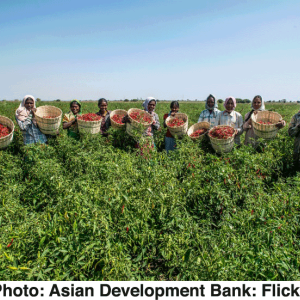
This policy research working paper by the world-bank has revisited numbers on women’s contribution to agriculture in sub-Saharan Africa. Its findings have challenged the development profession to revisit a number of claims about African economies, including those about the role of women in African agriculture.
The paper finds that women provide an average of 40% of the agricultural labour hours in crop production in sub-Saharan Africa, in contrast to the widely cited estimate of between 60-80%.
The paper is based on new data from six sub-Saharan African countries and provides new insights and rich detail about rural economies in this region. The new figures showing that women contribute with 40% of labour in the agriculture sector is closer to the evidence provided in the UN FAO 2010-11 State of Food and Agriculture report which showed that women make up about 50% of this sector’s labour force in Africa.
The new empirical evidence thus questions the assertion that substantial gains in aggregate crop output can result from efforts to increase female agricultural productivity.
However, a blog-post by Cheryl Doss on the website of the CGIAR programme on policies and institutions calls for caution on interpreting the new evidence. She makes three arguments for why this is important: 1) The new figures may not be directly inconsistent with the claims that women provide large shares of labour in agriculture as data is lacking on women’s share of labour in broader agricultural enterprises, not just labour used on plots. 2) The estimates are based on household agricultural production – the survey identifies which household members work in various agricultural activities on each plot – an approach that is not so relevant in places where the commercial agriculture sector is more important (NB: it is not clear whether including commercial labour would increase or decrease women’s share of the total). 3) Data: labour and time use data are notoriously difficult to obtain and Doss writes “To the extent that women are often not viewed as farmers or their tasks are undervalued within the culture, women’s labour may be underestimated, both by men and by the women themselves.”
Abstract
The contribution of women to labor in African agriculture is regularly quoted in the range of 60 to 80 percent. Using individual-disaggregated, plot-level labor input data from nationally representative household surveys across six Sub-Saharan African countries, this study estimates the average female labor share in crop production at 40 percent. It is slightly above 50 percent in Malawi, Tanzania, and Uganda, and substantially lower in Nigeria (37 percent), Ethiopia (29 percent), and Niger (24 percent). There are no systematic differences across crops and activities, but female labor shares tend to be higher in households where women own a larger share of the land and when they are more educated. Controlling for the gender and knowledge profile of the respondents does not meaningfully change the predicted female labor shares. The findings question prevailing assertions regarding substantial gains in aggregate crop output as a result of increasing female agricultural productivity.
Citation
Palacios-Lopez, A., Christiaensen, L., Kilic, T., ( 2015). How much of the labor in African agriculture is provided by women ?. Policy Research working paper; no. WPS 7282. Washington, D.C. : World Bank Group.
Read the full paper here.












Post a new comment »